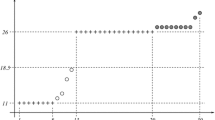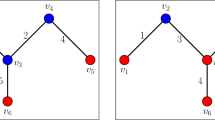Abstract
Canonical orderings and their relatives such as st-numberings have been used as a key tool in algorithmic graph theory for the last decades. Recently, a unifying link behind all these orders has been shown that links them to well-known graph decompositions into parts that have a prescribed vertex-connectivity. Despite extensive interest in canonical orderings, no analogue of this unifying concept is known for edge-connectivity. In this paper, we establish such a concept named edge-orders and show how to compute (1, 1)-edge-orders of 2-edge-connected graphs as well as (2, 1)-edge-orders of 3-edge-connected graphs in linear time, respectively. While the former can be seen as the edge-variants of st-numberings, the latter are the edge-variants of Mondshein sequences and non-separating ear decompositions. The methods that we use for obtaining such edge-orders differ considerably in almost all details from the ones used for their vertex-counterparts, as different graph-theoretic constructions are used in the inductive proof and standard reductions from edge- to vertex-connectivity are bound to fail. As a first application, we consider the famous Edge-Independent Spanning Tree Conjecture, which asserts that every k-edge-connected graph contains k rooted spanning trees that are pairwise edge-independent. We illustrate the impact of the above edge-orders by deducing algorithms that construct 2- and 3-edge independent spanning trees of 2- and 3-edge-connected graphs, the latter of which improves the best known running time from \(O(n^2)\) to linear time.










Similar content being viewed by others
References
Annexstein, F., Berman, K., Swaminathan, R.: Independent spanning trees with small stretch factors. Technical Report 96-13, DIMACS (June 1996)
Badent, M., Brandes, U., Cornelsen, S.: More canonical ordering. J. Graph Algorithms Appl. 15(1), 97–126 (2011)
Bender, M.A., Cole, R., Demaine, E.D., Farach-Colton, M., Zito, J.: Two simplified algorithms for maintaining order in a list. In: Proceedings of the 10th European Symposium on Algorithms (ESA’02), pp. 152–164 (2002)
Biedl, T., Derka, M.: The (3,1)-ordering for 4-connected planar triangulations. J. Graph Algorithms Appl. 20(2), 347–362 (2016)
Biedl, T., Schmidt, J.M.: Small-area orthogonal drawings of 3-connected graphs. In: Proceedings of the 23rd International Symposium on Graph Drawing (GD’15), pp. 153–165 (2015)
Cheriyan, J., Maheshwari, S.N.: Finding nonseparating induced cycles and independent spanning trees in 3-connected graphs. J. Algorithms 9(4), 507–537 (1988)
Curran, S., Lee, O., Yu, X.: Chain decompositions of 4-connected graphs. SIAM J. Discrete Math. 19(4), 848–880 (2005)
de Fraysseix, H., Pach, J., Pollack, R.: Small sets supporting fary embeddings of planar graphs. In: Proceedings of the 20th Annual ACM Symposium on Theory of Computing (STOC’88), pp. 426–433 (1988)
Djidjev, H.N.: A linear-time algorithm for finding a maximal planar subgraph. SIAM J. Discrete Math. 20(2), 444–462 (2006)
Even, S., Tarjan, R.E.: Computing an st-Numbering. Theor. Comput. Sci. 2(3), 339–344 (1976)
Gabow, H.N., Tarjan, R.E.: A linear-time algorithm for a special case of disjoint set union. J. Comput. Syst. Sci. 30(2), 209–221 (1985)
Galil, Z., Italiano, G.F.: Reducing edge connectivity to vertex connectivity. SIGACT News 22(1), 57–61 (1991)
Gopalan, A., Ramasubramanian, S.: A counterexample for the proof of implication conjecture on independent spanning trees. Inf. Process. Lett. 113(14–16), 522–526 (2013)
Gopalan, A., Ramasubramanian, S.: IP fast rerouting and disjoint multipath routing with three edge-independent spanning trees. IEEE/ACM Trans. Netw. 24(3), 1336–1349 (2016)
Hoyer, A., Thomas, R.: Four edge-independent spanning trees. SIAM J. Discrete Math. 32(1), 233–248 (2018)
Imai, H., Asano, T.: Dynamic orthogonal segment intersection search. J. Algorithms 8(1), 1–18 (1987)
Itai, A., Rodeh, M.: The multi-tree approach to reliability in distributed networks. In: 25th Annual Symposium on Foundations of Computer Science (FOCS’84), pp. 137–147 (1984)
Kant, G.: Drawing planar graphs using the lmc-ordering. In: Proceedings of the 33th Annual Symposium on Foundations of Computer Science (FOCS’92), pp. 101–110 (1992)
Lovász, L.: Computing ears and branchings in parallel. In: Proceedings of the 26th Annual Symposium on Foundations of Computer Science (FOCS’85), pp. 464–467 (1985)
Mader, W.: A reduction method for edge-connectivity in graphs. In: Bollobás, B. (ed.) Advances in Graph Theory. Annals of Discrete Mathematics, vol. 3, pp. 145–164. North-Holland, Amsterdam (1978)
McConnell, R.M., Mehlhorn, K., Näher, S., Schweitzer, P.: Certifying algorithms. Comput. Sci. Rev. 5(2), 119–161 (2011)
Mehlhorn, K., Neumann, A., Schmidt, J.M.: Certifying 3-edge-connectivity. Algorithmica 77(2), 309–335 (2017)
Mondshein, L.F.: Combinatorial Ordering and the Geometric Embedding of Graphs. Ph.D. thesis, M.I.T. Lincoln Laboratory/Harvard University (1971). Technical Report available at www.dtic.mil/cgi-bin/GetTRDoc?AD=AD0732882. Accessed 11 Sept 2018
Nagai, S., Nakano, S.: A linear-time algorithm to find independent spanning trees in maximal planar graphs. In: 26th International Workshop on Graph-Theoretic Concepts in Computer Science (WG’00), pp. 290–301 (2000)
Nakano, S., Rahman, M.S., Nishizeki, T.: A linear-time algorithm for four-partitioning four-connected planar graphs. Inf. Process. Lett. 62(6), 315–322 (1997)
Robbins, H.E.: A theorem on graphs, with an application to a problem of traffic control. Am. Math. Mon. 46(5), 281–283 (1939)
Schmidt, J.M.: Construction sequences and certifying 3-connectedness. In: Proceedings of the 27th Symposium on Theoretical Aspects of Computer Science (STACS’10), pp. 633–644 (2010)
Schmidt, J.M.: A simple test on 2-vertex- and 2-edge-connectivity. Inf. Process. Lett. 113(7), 241–244 (2013)
Schmidt, J.M.: The Mondshein sequence. In: Proceedings of the 41st International Colloquium on Automata, Languages and Programming (ICALP’14), pp. 967–978 (2014)
Schmidt, J.M.: Mondshein sequences (a.k.a. (2,1)-orders). SIAM J. Comput. 45(6), 1985–2003 (2016)
Whitney, H.: Non-separable and planar graphs. Trans. Am. Math. Soc. 34(1), 339–362 (1932)
Author information
Authors and Affiliations
Corresponding author
Additional information
Publisher's Note
Springer Nature remains neutral with regard to jurisdictional claims in published maps and institutional affiliations.
An extended abstract of this paper appeared at ICALP’17.
J. M. Schmidt: This research is supported by the Grant SCHM 3186/1-1 (270450205) from the Deutsche Forschungsgemeinschaft (DFG, German Research Foundation).
Rights and permissions
About this article
Cite this article
Schlipf, L., Schmidt, J.M. Edge-Orders. Algorithmica 81, 1881–1900 (2019). https://doi.org/10.1007/s00453-018-0516-4
Received:
Accepted:
Published:
Issue Date:
DOI: https://doi.org/10.1007/s00453-018-0516-4




